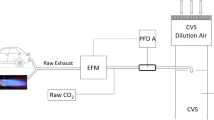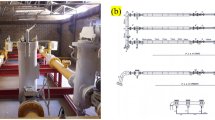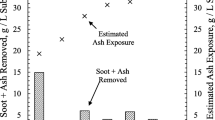Abstract
The control efficiency, concentration of particulate matter and emission rate of particulate matter were determined from a municipal incinerator equipped with an electrostatic precipitator.
An EPA and a modified ASME-ASTM particulate matter sampling train were used concurrently at precipitator inlet and outlet sampling ports to confirm the manufacturer's guarantee of collection efficiency and to determine compliance with local emission regulations.
A comparison of the weight of particulate matter collected during 22 test runs with each type of sampling train indicated that an out-of-stack filter in the current arrangement of the ASME-ASTM train results in a particulate matter catch which is comparable to that from the front portion of the EPA train.
A statistical Mest performed on the particulate matter catch from both sampling trains indicates no significance in the difference of the mean catch values of both the front portion and the combined front and back portions of the sampling trains.
Doubt is cast upon previous assertions that differences in the particulate matter caught by the two sampling trains are caused by the condensation of sulfur oxides and organic vapors within the back half of the EPA train. Rather, it appears that there is a loss of particulate matter from the Alundum thimble of the ASME-ASTM train that can be caught by a fiber glass out-of-stack filter.
Similar content being viewed by others
References
Federal Register, Vol. 36, No. 159, Part II: 1971, ‘Standards of Performance for New Stationary Sources Notice of Proposed Rule Making’ Method 5.
Federal Register, Vol. 36, No. 247, Part III: 1971, ‘Standards of Performance for New Stationary Sources’ Method 5.
American Society for Testing and Materials Proposed Method D 22-06: 1973, ‘Proposed Method of Test for Sampling Stacks for Particulates and Collected Residue Simultaneously’.
American Society of Mechanical Engineers, Power Test Code 21: 1941, ‘Dust Separating Apparatus’, New York.
American Society of Mechanical Engineers, Power Test Code 27: 1957, ‘Determining Dust Concentration in a Gas Stream’, New York.
American Society for Testing and Materials, Standard No. D 2928-71: 1971, ‘Standard Method for Sampling Stacks for Particulate Matter’, Philadelphia.
New York City Contract No. 220415: 1972, ‘Improvements for Air Pollution Control at Existing Incinerators — Test Program for the Determination of Dust Emission and Gaseous Effluents from South Shore Incinerator Furnace No. 4 at Torbell Street and Wortman Avenue, Brooklyn, N.Y.’, Capital Project No. S-157.
Selle, S. J. and Gron Hovo, G. H.: 1973, ‘Some Comparisons of Simultaneous Stack Gas Particulate Determination Using the ASME and EPA Methods’ Trans. ASME, Journal of Engineering for Power, p. 145.
Hemeon, Wesley C. L. and Black, A. W.: 1972, ‘Stack Dust Sampling: In-Stack or EPA Train’, J. APCA, 22, 516.
Edwards, A. L.: 1967, Statistical Methods, 2nd edn., Holt, Rhinehart and Winston, Inc., New York.
Author information
Authors and Affiliations
Rights and permissions
About this article
Cite this article
Lieberstein, M. A comparison of the particulate matter catch from EPA and modified ASME-ASTM sampling trains. Water Air Soil Pollut 9, 369–384 (1978). https://doi.org/10.1007/BF00280686
Received:
Revised:
Issue Date:
DOI: https://doi.org/10.1007/BF00280686




